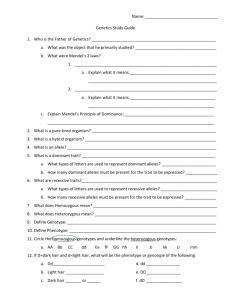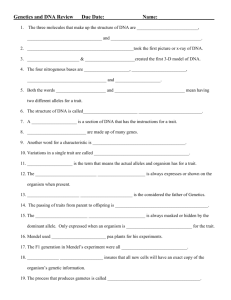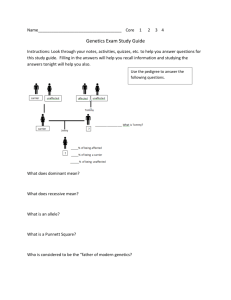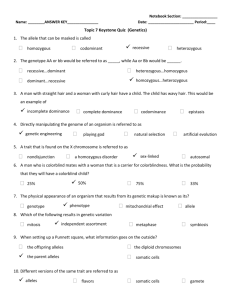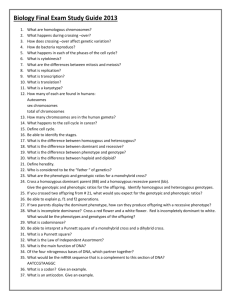review_answers_ch._5__6_0
advertisement
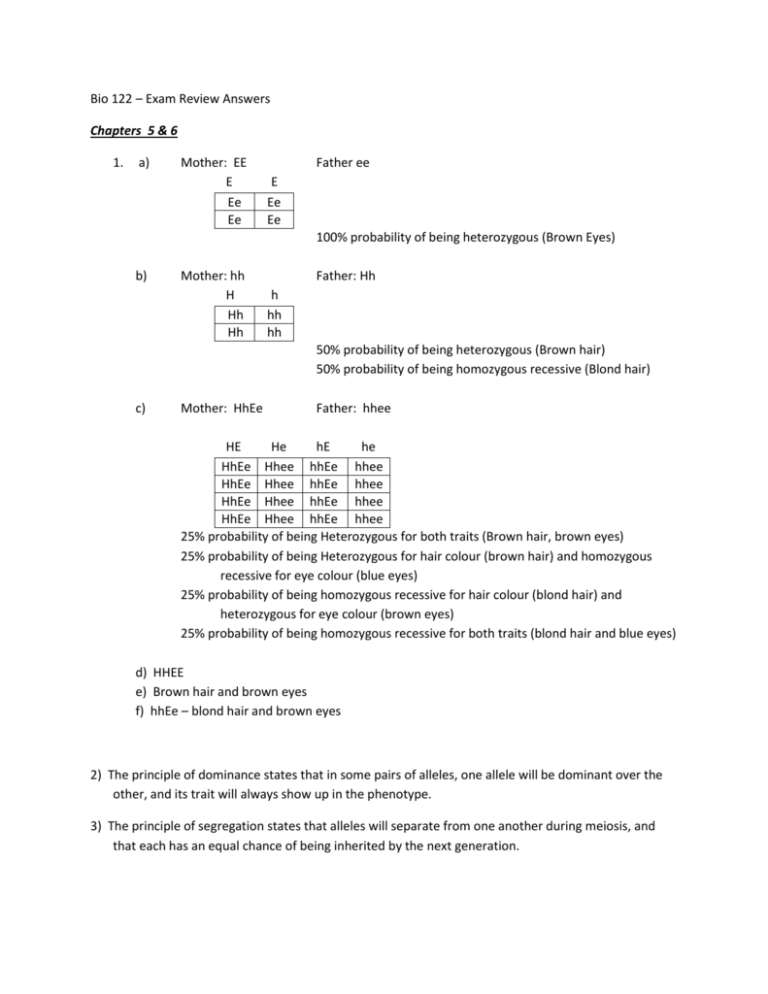
Bio 122 – Exam Review Answers Chapters 5 & 6 1. a) Mother: EE E Ee Ee Father ee E Ee Ee 100% probability of being heterozygous (Brown Eyes) b) Mother: hh H Hh Hh Father: Hh h hh hh 50% probability of being heterozygous (Brown hair) 50% probability of being homozygous recessive (Blond hair) c) Mother: HhEe Father: hhee HE He hE he HhEe Hhee hhEe hhee HhEe Hhee hhEe hhee HhEe Hhee hhEe hhee HhEe Hhee hhEe hhee 25% probability of being Heterozygous for both traits (Brown hair, brown eyes) 25% probability of being Heterozygous for hair colour (brown hair) and homozygous recessive for eye colour (blue eyes) 25% probability of being homozygous recessive for hair colour (blond hair) and heterozygous for eye colour (brown eyes) 25% probability of being homozygous recessive for both traits (blond hair and blue eyes) d) HHEE e) Brown hair and brown eyes f) hhEe – blond hair and brown eyes 2) The principle of dominance states that in some pairs of alleles, one allele will be dominant over the other, and its trait will always show up in the phenotype. 3) The principle of segregation states that alleles will separate from one another during meiosis, and that each has an equal chance of being inherited by the next generation. 4) The principle of independent assortment states that each gene can be independently passed on to the next generation. Having one gene does not make you more or less likely to receive another gene. 5) DNA can be used to identify criminals through the process of gel electrophoresis. Each person’s DNA is unique and will result in a unique pattern of bands within the DNA. Band patterns can be matched to identify two samples of DNA from the same source. a. A person’s DNA is cut using restriction enzymes. b. The resulting molecules are placed in wells in the gel. An electrical current is run through the gel, and DNA migrated toward the positive end. Smaller molecules move faster than larger ones and the result is a distinctive pattern of “bands”. c. The band patterns can be compared to identify two samples of DNA from the same source. 6) Sex linked chromosomes affect inheritance patterns because in males, who have an X and a Y chromosome, the Y chromosomes often does not carry homologous genes to the those on the X chromosome. This means the principle of dominance doesn’t apply and all genes on the X chromosome are expressed, even if recessive. This does not happen in females where the regular patterns of inheritance apply. A daughter can inherit a sex-linked chromosomal disorder from her dad, but he must express the disorder himself, and the mother must either be a carrier or express the disorder as well. 7) Genotype: The allele combination found on a person’s chromosomes. Phenotype: The expressed trait, as a result of the principle of dominance. 8) Incomplete dominance occurs when two traits both try to dominate over each other, but neither succeeds, resulting in a “blended” trait. Co-dominance occurs when two traits both dominate within the same organism and both traits appear. 9) a. True-breeding plant – a self-fertilizing that that has been fertilizing itself for so many generations that the result is a “known” homozygous genotype. b. Hybrid – a genotype that contains 2 different alleles. c. F1 – The first offspring generation F2 – The second offspring generation, or grandchildren of the original generation. P – the parent generation, or original organisms. d. Genes – Specific sections of DNA located on specific chromosomes that code for a particular trait. e. Alleles – the different versions of a gene.


